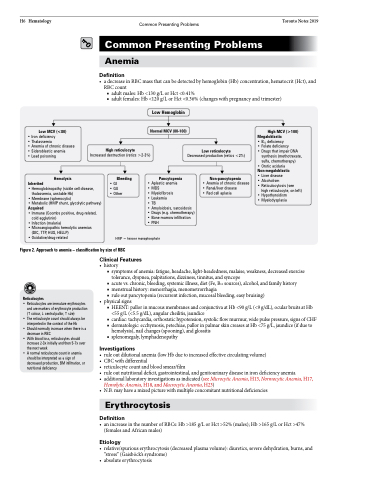Page 546 - TNFlipTest
P. 546
H6 Hematology
Common Presenting Problems Toronto Notes 2019 Common Presenting Problems
Anemia
Definition
• adecreaseinRBCmassthatcanbedetectedbyhemoglobin(Hb)concentration,hematocrit(Hct),and RBC count
■ adult males: Hb <130 g/L or Hct <0.41%
■ adult females: Hb <120 g/L or Hct <0.36% (changes with pregnancy and trimester)
Low MCV (<80)
• Iron deficiency
• Thalassemia
• Anemia of chronic disease • Sideroblastic anemia
• Lead poisoning
Hemolysis Inherited
• Hemoglobinopathy (sickle cell disease, thalassemia, unstable Hb)
• Membrane (spherocytic)
• Metabolic (HMP shunt, glycolytic pathway) Acquired
• Immune (Coombs positive, drug-related,
cold agglutinin)
• Infection (malaria)
• Microangiopathic hemolytic anemias
(DIC, TTP, HUS, HELLP)
• Oxidative/drug-related
Low Hemoglobin Normal MCV (80-100)
High MCV (>100) Megaloblastic
• B12 deficiency
• Folate deficiency
• Drugs that impair DNA
synthesis (methotrexate,
sulfa, chemotherapy) • Orotic aciduria Non-megaloblastic
• Liver disease
• Alcoholism
• Reticulocytosis (see
high reticulocyte, on left) • Hypothyroidism
• Myelodysplasia
Figure 2. Approach to anemia – classification by size of RBC
High reticulocyte
Increased destruction (retics >2-3%)
Low reticulocyte
Decreased production (retics <2%)
Non-pancytopenia
• Anemia of chronic disease • Renal/liver disease
• Red cell aplasia
Bleeding
• GI
• GU
• Other
• • • • • • • • •
Pancytopenia
Aplastic anemia MDS Myelofibrosis Leukemia
TB
Amyloidosis, sarcoidosis Drugs (e.g. chemotherapy) Bone marrow infiltration PNH
Reticulocytes
• history
■ symptomsofanemia:fatigue,headache,light-headedness,malaise,weakness,decreasedexercise
tolerance, dyspnea, palpitations, dizziness, tinnitus, and syncope
■ acute vs. chronic, bleeding, systemic illness, diet (Fe, B12 sources), alcohol, and family history
■ menstrualhistory:menorrhagia,menometrorrhagia
■ ruleoutpancytopenia(recurrentinfection,mucosalbleeding,easybruising)
• physicalsigns
■ HEENT:pallorinmucousmembranesandconjunctivaatHb<90g/L(<9g/dL),ocularbruitsatHb
• Reticulocytes are immature erythrocytes
and are markers of erythrocyte production
(h colour, i central pallor, h size) <55 g/L (<5.5 g/dL), angular cheilitis, jaundice
• The reticulocyte count should always be interpreted in the context of the Hb
• Should normally increase when there is a decrease in RBC
• With blood loss, reticulocytes should increase 2-3x initially and then 5-7x over the next week
• A normal reticulocyte count in anemia should be interpreted as a sign of decreased production, BM infiltration, or nutritional deficiency
■ cardiac:tachycardia,orthostatichypotension,systolicflowmurmur,widepulsepressure,signsofCHF ■ dermatologic:ecchymosis,petechiae,pallorinpalmarskincreasesatHb<75g/L,jaundice(ifdueto
hemolysis), nail changes (spooning), and glossitis ■ splenomegaly,lymphadenopathy
Investigations
• ruleoutdilutionalanemia(lowHbduetoincreasedeffectivecirculatingvolume)
• CBCwithdifferential
• reticulocytecountandbloodsmear/film
• ruleoutnutritionaldeficit,gastrointestinal,andgenitourinarydiseaseinirondeficiencyanemia
• additionallaboratoryinvestigationsasindicated(seeMicrocyticAnemia,H13,NormocyticAnemia,H17,
Hemolytic Anemia, H18, and Macrocytic Anemia, H23)
• N.B.mayhaveamixedpicturewithmultipleconcomitantnutritionaldeficiencies
Erythrocytosis
Definition
• anincreaseinthenumberofRBCs:Hb>185g/LorHct>52%(males);Hb>165g/LorHct>47% (females and African males)
Etiology
• relative/spuriouserythrocytosis(decreasedplasmavolume):diuretics,severedehydration,burns,and “stress” (Gaisböck’s syndrome)
• absoluteerythrocytosis
HMP = hexose monophosphate
Clinical Features


